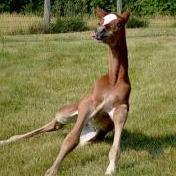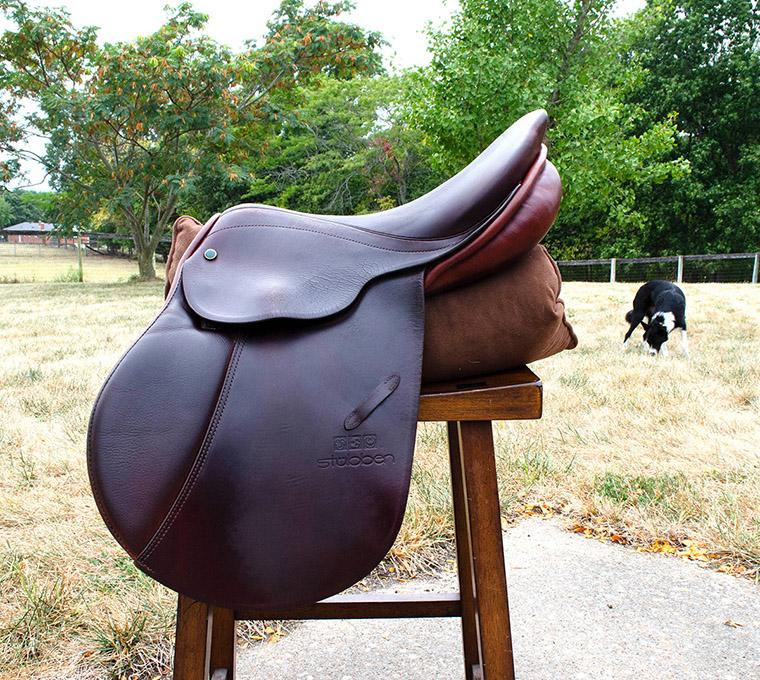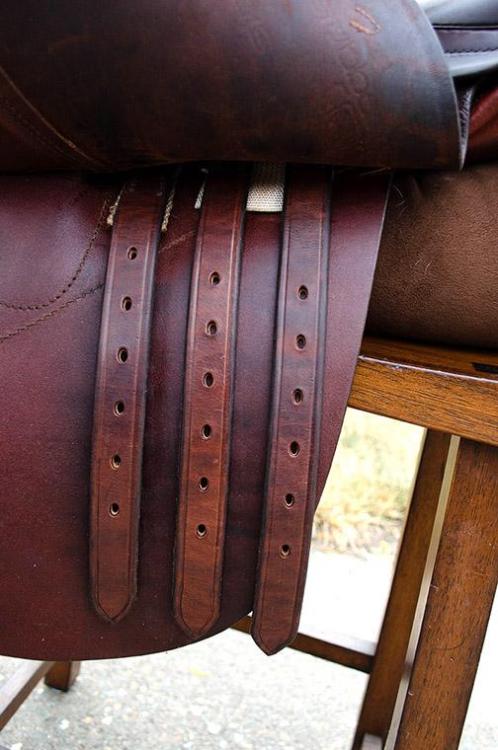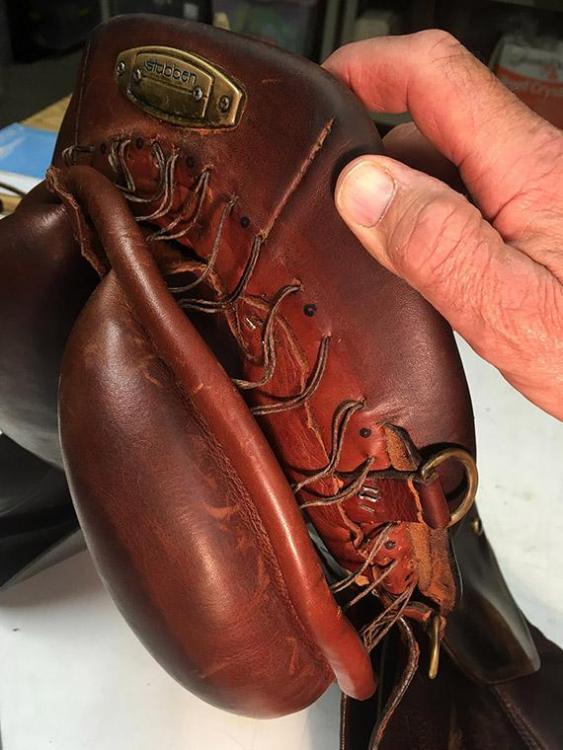-
Posts
1,281 -
Joined
-
Last visited
Content Type
Profiles
Forums
Events
Blogs
Gallery
Everything posted by TomE
-
@bethgay what a great story! Made my day. Hope you are well.
-
I normally charge $150 to change billets, which is what I quoted to this client. I figure about 1 hr to make the billets - edge finishing, punching 6-7 buckle holes and 12 holes for sewing onto the webs. Dressage saddles have 4 billets (~2 ft long) and jumping saddles have 6 billets (~1 foot long). Another 1-1/2 hrs to disassemble the panel, sew the billets, and restitch the front of the panel. Materials are 6-8 feet of 1" strap from the best part of the hide, some thread, and staples. Some saddles have surprises like a billet that is directly riveted to the tree. For sewing the billets, I use a single needle backstitch with doubled up 0.040" waxed polyester thread from the Maine Thread Co. The billets are pre-punched with 6 holes in 2 lines. I avoid pushing an awl through the webs so I don't cut the threads. The backstitch pattern gathers more threads per stitch on the backside when sewing leather to woven fabric. This saddle took considerably longer to completely remove the panel - cut the lacing in back, remove ~15 staples - and then to restaple and lace the panel to the back of the seat. All this disassembly was required to expose 4 staples that attach the 2 tabs on the front of the panel (see in picture above) to the tree. I think my prices will be increasing. I've seen saddlers listing a price of $180-$200 for changing billets. I messaged Stubben's saddler/service manager about this particular saddle. He said it is the most difficult construction that he deals with (PIA in his words) and he charges $300 for this type.
- 33 replies
-
- panel
- jumping saddle
-
(and 2 more)
Tagged with:
-
Thanks Jonas! I recently replaced the billets on a dressage saddle that had the front billet directly riveted to the tree, instead of a short web riveted to the tree. I ended up buying 3/16" solid aluminum rivets to match existing, and a dome shaped rivet setter that fits on an air hammer. Worked out fine after I practiced setting rivets. On this saddle I learned how to use a pneumatic staple gun. Decreased the air pressure to ~55 psi so it would drive the 1/4 x 3/4" staples into oak with a piece of 6 oz leather on top, without damaging the leather. Once I got it dialed in, it worked well driving staples into the plastic tree.
- 33 replies
-
- panel
- jumping saddle
-
(and 2 more)
Tagged with:
-
Stohlman's Encyclopedia of saddle making is a fairly complete description of western saddle making, from the perspective of someone who hasn't built a saddle. There are also books and DVDs at the Leather Crafters Journal online store. The only references I've found for English saddle making are old books. Steinke's book "Repair Your Own Saddlery and Harness is useful, but becoming rare and expensive.
- 33 replies
-
- panel
- jumping saddle
-
(and 2 more)
Tagged with:
-
It's a tree. Traditionally made of spruce and steel. This one is a plastic material and steel. The longer webs that run lengthwise support the seat (like a hammock), and the webs running side to side attach to the billets.
- 33 replies
-
- panel
- jumping saddle
-
(and 2 more)
Tagged with:
-
Just finished the repair today. I didn't take a picture of sewing the new billets (girth straps) on the web. In the second picture, you can see the white nylon webbing with the new billets attached. The stitching is hidden under the flap, which is why all this has to come apart to change out the billets. Jumping saddles have 6 billets but only 4 are buckled to the girth at a time. Allows for some adjustment. The 3rd picture shows how the panel is attached to the back of the seat by "lacing" with heavy thread in a zig-zag pattern. The thread is run through all the holes before pulling it tight to draw the panel tightly against the seat. The panel serves as padding to cushion the saddle on the horse's back. It is filled with wool flocking that can be adjusted (add or remove wool) to fit a horse's back. You can see the whole panel in the lower part of the 1st picture. it has 2 pockets that fit over the points of the tree (the curved metal piece in first picture with 2 leather pads on the tips of the points that fit into the pockets of the panel. English saddles are sort of like leather upolstery.
- 33 replies
-
- panel
- jumping saddle
-
(and 2 more)
Tagged with:
-
Learned something new this week. This children's jumping saddle is a Stubben Edelweiss CS that needed new billets. I am familiar with saddles that have stitching or screws to secure the front end of the panel. It is usually necessary to drop the front of the panel off the points of the tree to access the stitching on the billets. This saddle had no stitching or screws visible, so I contacted Jack Stewart who is the saddler and service manager for Stubben North America. He replied within minutes on a Saturday explaining the whole process. Thank you, Jack! To access the billets on this saddle it's necessary to cut the lacing on the back of the panel then remove staples and peel the gullet forward in order to expose staples that secure the front of the panel to the tree. Once all the staples are out the panel can be removed and the billets are easy to swap out. I made them out of 11-12 oz Hermann Oak harness leather. This project gave me an excuse to buy a pneumatic stapler to drive the 1/4" x 3/4" crown staples holding the gullet and the ends of the panel on the tree. I had already quoted a price to the client for this repair, but it was more involved than I realized. The price of an education.
- 33 replies
-
- panel
- jumping saddle
-
(and 2 more)
Tagged with:
-
I mostly work on English tack, but here are some thoughts. I bought a side of HO 11-12 oz latigo that is beautiful leather. I've used it to make a bridle, some straps, and saddle strings (lace). I split it to ~5-6 oz and beveled the edges for saddle strings. I think Bruce Cheaney has a video about this. Lubricate generously with saddle soap before lacing. Harness leather is another choice for saddle billets. It is strong and weatherproof. It is my go-to for English saddle billets. Hermann Oak Leather sent me samples of all the colors they make (black and chocolate were my choice for English saddles). They will sell you items that aren't stocked by their retailers without the usual 5 side minimum order.
-
Another key to feeding variabile thickness is your preparation of the transitions - skiving to create gradual changes in thickness. For 5 oz leather handbags, a bell skiver would be useful to ease the transitions at seams and junctions. The Class 26 (341 type clone) is a great climber in my experience. Makers Leather Supply has a lot of tutorials and patterns for handbags. I mostly sew heavier straps on a 441 type machine. I will add a wedge-shaped welt to the returns where the strap wraps around hardware, and skive the end of the strap to create a smooth transition. I've also found that the narrow throat plates and pressor feet that are available for 441 type machines (search these forums) provide stability and do a good job climbing a transition. The type of leather also matters. I mostly use thick bridle and harness leathers that are waxy, causing material to slip if you're not careful feeding it.
-
Small world! I bought the same knife from Amazon and have been pleased with it. I did reprofile the blade with a more shallow taper. Harry Rogers also approves of this cheap knife.
-
The plate with spikes is a loop staple. Weaver sells them https://www.weaverleathersupply.com/products/15s4-loop-staples and Beiler's Manufacturing has smaller quantities. You can also sew the loop. Sewing and blocking a loop is a higher level of finish in my opinion.
-
They don't have a website. Amish business. Call for a catalog.
-
Beiler's sells cream and golden colored veg tanned sheepskin in various sizes. I am happy with the quality of the 12 ft skin I purchased. They also have chrome tanned sheepskin in cream, golden, and black.
-
The Class 26 is a workhorse. I’ve been impressed with how well it navigates varying thickness, such as sewing hardware on a strap, and tight spots where there’s little room for the outside foot. I keep it loaded with #138 thread and use it more frequently for items that I used to sew by hand. Great complement to a 441 type machine.
-
While we're at it, what about Fiebing's Saddle Oil? It contains silicon oils and ? I use it on work boots and it leaves them dark and oily. Does anyone use it on saddles or other veg tan leather? I was recently contacted by someone who wanted me to clean their dressage saddle and replace the billets. They had applied lots (?) of Saddle Oil to soften the leather and weren't happy with the results. I didn't see the saddle and told them to bring it to me after they clean it thoroughly with detergent (Murphy's Oil Soap, castile soap, or dish washing liquid) then clean it again with saddle soap and lots of clean water.
-
I am able to read the article after dismissing the popup window inviting me to subscribe. The only other source I know of is his articles in the Leather Crafters Journal.
-
I routinely oil bridle leather that is 9-12 oz. A light coat at the end of the project. It soaks right in and softens the leather a little, which is what I'm after. Don't need to apply heat. Even harness leather that is loaded with fats and oils will take up neatsfoot oil at room temp. Jason Timmermans did a systematic study of leather hardening methods. He's written articles for the Leather Crafter's Journal and published this online. https://medium.com/@jasontimmermans/a-comparative-study-of-leather-hardening-techniques-16-methods-tested-and-novel-approaches-8574e571f619
-
Nice! Hope it goes well. I need a good luck charm at the dentist next week.
-
Yes, the only adverse effect I've seen is when a trainer soaked some of our pony tack in neatsfoot compound and made it permanently spongey and sticky to the touch. Probably would have had the same outcome by soaking - over oiling - in pure neatsfoot oil. The idea of hot oiling (heating neatsfoot oil in a crock pot before applying) boggles my mind. I would think if the oil isn't absorbed at room temperature then it isn't needed.
-
I’ve grown fond of every machine in my shop but if I had to choose I’d keep the splitter, or maybe the power burnisher. I like to hand sew, hate to rub edges, and make lots fiddly little parts of different thicknesses.
-
I haven’t used compound but the Stohlmans mention (Encyclopedia of Saddle Making) they used the compound a lot without any bad effects although pure neatsfoot oil is no doubt the best.
-
Thank you for all this information, @Landcruzer94. I will work through it carefully as I become more familiar with the Class 26. Which Juki manual are you working from? LS-341? LS-1341? My first machine was a Class 4 that I knocked out of time shortly after I bought it. Uwe's video on timing the 441 type machines was a great help.
-
Robert Steinke is a master saddler living in Ireland. He authored books on bridlework, harness and saddle repairs, and harness brasses. He recently resumed leatherwork and is active on Facebook. I'd ask him for advice if you're interested in English tack and harness work. Here is another resource for courses in saddlery and harness work https://walsall-leather.org/
-
To narrow the possibilities, I would test with thin veg tan leather and a TRI point needle. I am interested in learning more about this symptom. I mainly sew heavier leather with #138 thread on a Class 26.
-

Help Finding Conchos and Rivets for Bronc Noseband
TomE replied to Fraulein's topic in Hardware and Accessories
Beiler's has crystal spots and saddlery (metal) spots and setters.






